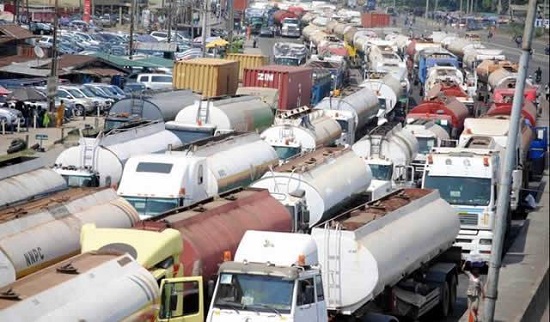This post has already been read 1999 times!
I do not know if those in positions of authority have taken a closer look on the above subject matter with a view to honestly finding out why the situation persists. The situation persists because the root cause of the problem has not been addressed. The truth of the matter is that every track truck on the road (except faulty ones) has a destination and therefore has a purpose. The question to be addressed is this: Why does it take a truck from point “A’ or ‘B’ in Lagos, or from anywhere three weeks to one month to access either the Tin Can or Apapa Port?
The truck driver who leaves his family for a journey that ordinarily will take him a few hours will end up spending between three weeks and one month outside without seeing his family. They sleep, eat, bathe, defecate, urinate, and wash their clothes outside as long as the journey lasts. They live like semi-human beings. Nobody is talking about their health.
The state of the Oshodi/Apapa Expressway is, to say the least, a death trap. As bad as it is, it is not the main cause of the gridlock. Has anyone asked why the Nigerian Ports Authority after concessioning the ports still insists on manning the gates, dictating who and what go in, when and how they go in? The NPA has even extended its grip to wherever there is a truck carrying a container. That is why you can see its officials at Ijora Olopa, Ijora Seven Up, Costain, Marine Bridge, Mile 2, Cocoanut, to mention but a few places. They have successfully connived with security outfits (especially the task force) to deny containers and truckers access to the ports. The NPA, instead of ensuring that the terminal operators deliver on easy access to the ports to enhance trade, connived with the terminal operators to make it very difficult and expensive for truckers to access the ports. For a truck with an empty container on it going to the port, common sense will suggest that it is going to drop the container. A flat body truck with a loading order going to the port, common sense will also suggest that it is going to load a consignment (import). Why then should the truckers be subjected to another double “call-up ‘letters from both the Navy and the NPA?
This exercise takes time and it is not free. This is a part of the problems. Has anybody asked why the gridlock terminates at the port gates? If the terminal operators are competent, it takes little or no time for a truck to go inside the terminal port, offload the empty container or load a consignment (import) and leave, but the reverse is the case. If the terminal operators have enough and proper equipment, enough and qualified manpower to man every operational area in the terminal, we will not get to this mess. The terminal operators connive with the NPA and the other security agencies at the gate to delay trucks from accessing the ports easily. They advance a lot of flimsy reasons to cover up their inefficiency. If the terminal operators have, for instance, two Reach stacker machines professionally manned to take care of empties dropoff, the same for import delivery, and the same for every operational department in the post, the situation will witness a surprising change. But what do we have now? One or two half-functioning Reach stacker machines not professionally manned doing all the operational work in the terminal. It is therefore the terminal operators that can end the gridlock if they decide to do the right things.
The truth is that most of the terminal operators, the shipping companies and the other agencies that are involved in cleaning the gridlock benefit from the ugly situation as it is now. While the truckers cannot access the terminal (port) to load import, the terminal operators collect demurrage daily even when they are responsible for the delay. Again, even if it takes the truck one month to access the port and drop the empty container, the shipping companies charge demurrage till the day the empty container is finally dropped. For the other security agencies, the heavier the traffic, the happier they are.
My humble suggestions: The NPA and the task force need to work inside the terminal to ensure that the terminal operators participate in trade facilitation by enhancing operational efficiencies. Two, clearing agents and transport owners should constitute a part of any task force at the port. Three, terminal demurrage should stop as soon as the loading order is generated by the terminal operators. Four, shipping company demurrage should stop as soon as the shipping company generates the delivery order. Five, government should reduce the authority of the NPA at port gates, and also engage the services of competent professionals to fix the roads leading to the ports without further delays.
All the activities/operations of the Customs FOU, strike force, compliance team and SON around the port in front of the Leventis building facing Area ‘B’ Police Command on Wharf Road, Apapa, should cease with immediate effect. The commercial buses loading within the same area should relocate to the NAGAFF village side. This is to ensure that trucks and other vehicles leaving the ports to do so without hindrance. The road from the port through Wharf Road to Ijora Seven Up, down to the National Stadium to Ojuelegba should always flow freely. The NPA should tow any truck or any other vehicle that obstructs the free flow of traffic around the ports. Those offloading their imports along Burma Road, Apapa, should desist from such acts immediately.
Chief Tony Onuora, Apapa, Lagos
[Punch]



